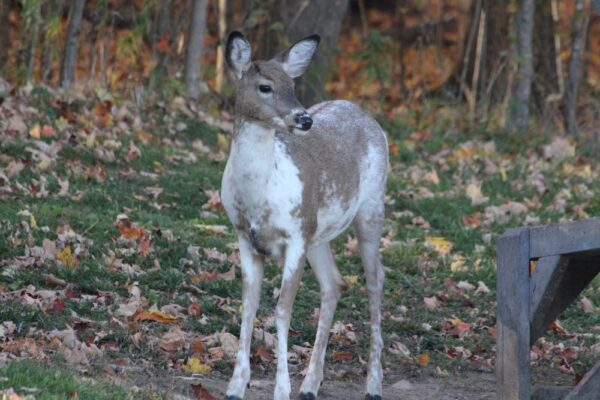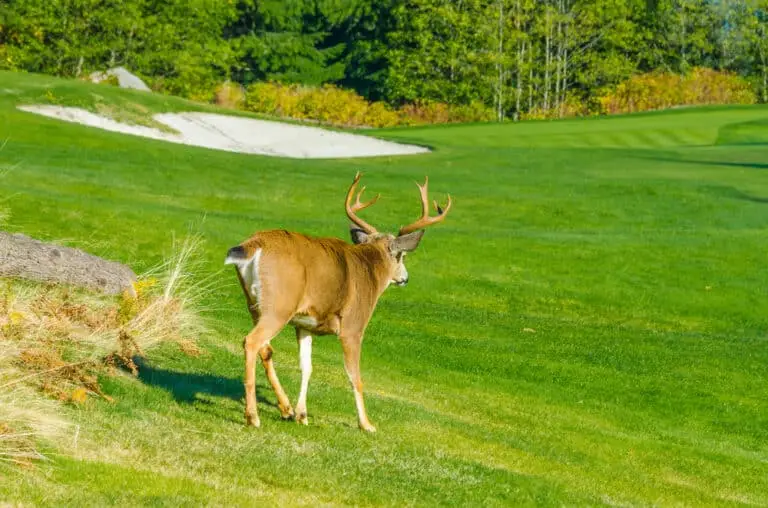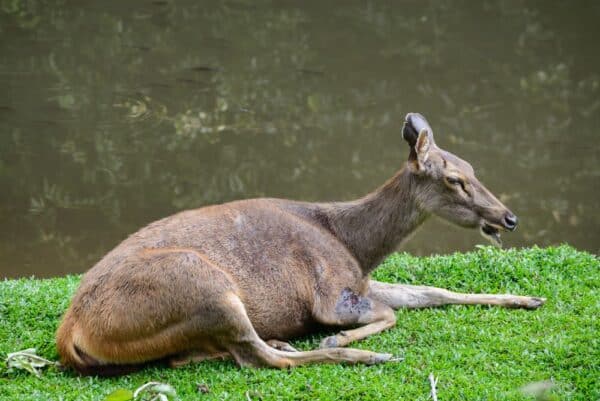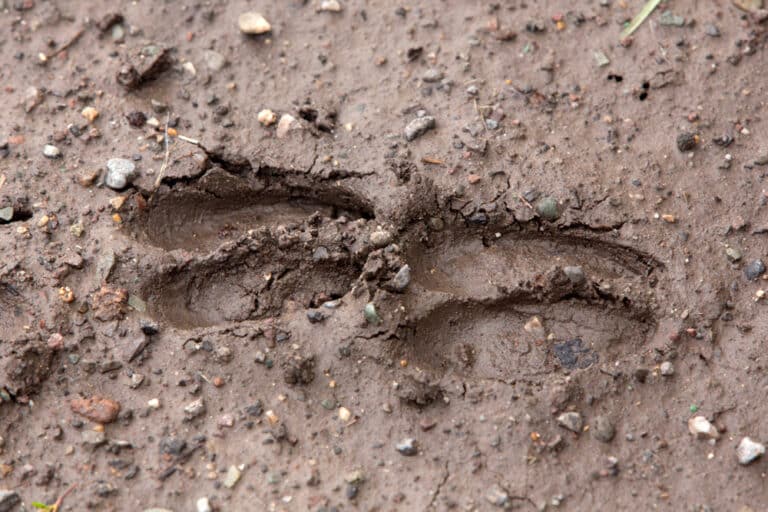The elusive Vietnamese mouse deer, a hoofed animal no bigger than a rabbit with tiny fangs and known as the world’s smallest ungulate, was found alive in the dense forests of southern Vietnam after nearly three decades. This remarkable rediscovery by Global Wildlife Conservation and local forest rangers have reignited interest in this endangered species.
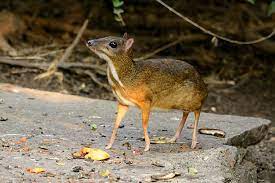
This blog post delves into innovative wildlife research techniques for monitoring these wild animals. We explore their unique behavior patterns and habitat preferences on the forest floor, such as their affinity for bamboo-dominated crown-gap areas.
We also discuss how radiotracking devices are being utilized to track the movements of these diminutive creatures. Furthermore, we will address pressing threats against their survival prospects due to illegal hunting practices and habitat loss.
Finally, you’ll learn about local communities’ pivotal role in conservation efforts for this fascinating creature – from participating in survey works to fostering partnerships to achieve sustainability goals for our precious global wildlife heritage.
Rediscovery of the Elusive Vietnamese Mouse Deer
The silver-backed chevrotain, also known as the mouse deer, was considered extinct until it made a surprise comeback in a Vietnamese forest. Talk about a disappearing act.
Camera Traps: The Wildlife Paparazzi
To catch a glimpse of these sneaky creatures, scientists set up camera traps that snap photos when triggered by movement or heat changes. Say cheese, mouse deer.
With 275 snapshots of our long-lost friend, the mouse deer, the scientists couldn’t believe their luck. It’s like a nearly-impossible feat but with an adorable twist.
Expanding the Vietnamese Mouse Deer Fan Club
We’re all out to protect these little guys now that we’ve found them. We’re setting up more camera traps and getting the local communities involved. Teamwork makes the dream work.
By collaborating, we can gain insight into the conduct of mouse deer and guarantee they have a secure habitat. Let’s give them the VIP treatment they deserve.
Understanding the Behavior and Habitat Preferences
The elusive mouse deer, or silver-backed chevrotain, has fascinated wildlife enthusiasts and researchers. Its recent rediscovery in Vietnam’s dense forests provided a golden opportunity to study its behavior and habitat preferences.
Diurnal Pattern Behavior of the Vietnamese Mouse Deer
Contrary to common assumption, these diminutive animals demonstrate activity throughout the daylight hours. Maybe they’re not fans of nightclubs or prefer brunch over midnight snacks. Either way, this discovery helps us plan conservation strategies better.
Preference for Bamboo-Dominated Crown-Gap Areas
These mouse deer have a thing for bamboo-dominated crown-gap areas. They say, “Move over, closed forests; we want the best seats in the house.” These open spaces provide them with plenty of food and a better view of potential predators.
- Bamboo dominance: These deer love the lush greenery of bamboo plants. It’s like an all-you-can-eat buffet and a cozy hideout rolled into one.
- Crown gaps: Fallen trees create natural clearings, giving these deer easy access to various plants. It’s like having a VIP entrance to a botanical wonderland.
- Safety considerations: Open spaces allow them to spot danger early on. It’s their version of having eyes in the back of their heads, except they don’t have eyes in the back.
This newfound understanding of mouse deer behavior can help us protect these adorable creatures from environmental challenges. Let’s ensure their survival and keep the circle of life going.
Using Fall-Cage Traps on The Vietnamese Mouse Deer
To catch these elusive creatures safely, researchers employ fall-cage traps. These traps effectively capture small mammals like the mouse deer without causing them harm. The Journal of Mammalogy provides insights into how these traps can be used effectively.
Handling these animals carefully and releasing them quickly back into their natural habitat after attaching radiotracers ensures their well-being.
Application of Radiotracking Devices on The Vietnamese Mouse Deer
Radiotracking devices play a significant role in monitoring the movements of mouse deer over extended periods. They provide invaluable data about their daily routines, feeding habits, mating patterns, and territorial behaviors. The Journal of Zoology showcases a successful case study on tracking lesser mouse-deer populations in Malaysia, offering valuable insights into their ecology and behavior.
- Data collection: Radiotracking devices securely attached to captured individuals provide continuous updates on their locations, helping researchers map out their frequented areas and understand their spatial distribution within more significant landscapes.
- Data analysis: Analyzing data collected over five months revealed seasonal variations in activity levels and identified potential threats from human disturbances, such as illegal hunting activities.
Tracking technology aids scientific research in preserving biodiversity and addressing environmental degradation caused by unsustainable human actions. Let’s strive to strike a balance between progress and preservation for the sake of our planet’s future.
Threats to Survival: Vietnamese Mouse Deer in Peril
Vietnam’s elusive mouse deer population faces a severe threat to its existence. The main culprit? Illegal hunting practices using snares wreak havoc on endangered mammals and birds.
Snares: A Wildlife Menace
Snares pose a significant danger to wildlife, unintentionally trapping and harming animals. These traps, set up by hunters to catch a giant game, ensnare smaller creatures like the silver-backed chevrotain or mouse deer. With no regard for species, snares wreak havoc on biodiversity.
A Global Ecology and Conservation Journal study revealed that an estimated 12.3 million snares threaten wildlife in protected areas of Southeast Asia. This alarming figure highlights the urgent need for stricter regulations against these harmful practices.
Conservation Action Required
In the face of this crisis, immediate action is crucial to protect vulnerable species from the brink of extinction. Strengthening law enforcement against illegal hunting and raising public awareness about conservation initiatives are vital approaches.
- Educational campaigns: Educating local communities about the devastating effects of snare trapping on ecosystems and animal populations can foster a greater appreciation for wildlife preservation.
- Tighter legislation: Governments should consider implementing stricter laws and penalties for those involved in illicit hunting activities and regular patrolling to ensure compliance.
- Habitat restoration: Restoring degraded environments provides safer spaces where threatened species like the mouse deer can thrive without falling into deadly traps left behind by hunters.
No matter how small, every living organism is essential to its surrounding environment. Let’s be responsible stewards of nature and strive for harmonious coexistence with all life forms on our shared planet. Together, we can preserve the precious biodiversity that offers hope for a brighter tomorrow.
The critical importance of local communities in conservation efforts is indisputable. These groups, living near wildlife reserves and vulnerable ecosystems, are the eyes and ears on the ground, providing invaluable insights into animal behavior, habitat preferences, and potential threats.
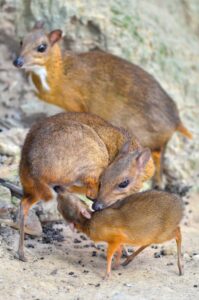
Role of Local Communities in Survey Works
We’ve seen how vital local communities can be in our work with the elusive mouse deer or silver-backed chevrotain. Their knowledge of the environment helps us locate these rare creatures. From identifying habitats to spotting signs of activity, their contributions are invaluable.
This is not limited to Vietnam, where we recently rediscovered this species after nearly three decades. Check out this Nature Ecology & Evolution article about rediscovery. Global conservation efforts are driven by communities worldwide, focusing on protecting endangered species and preserving biodiversity. Read more in this Conservation Biology journal article about global community-led initiatives.
Fostering Partnerships for Sustainability Goals
Acknowledging the pivotal role of local communities emphasizes the need for strong partnerships between them and scientific researchers like us at DeerDonkey.com. Collaboration is critical to achieving long-term sustainability goals aligned with conservation objectives.
- We provide training sessions for locals interested in participating actively in our research projects.
- We organize regular meetings where they can share observations or raise concerns affecting their surroundings.
- We strive to create platforms enabling open dialogues, encouraging mutual respect and understanding, and enriching overall project outcomes.
Such partnerships ensure that our work remains grounded in reality and empower individuals to take ownership of protecting natural resources found within their backyards. Check out this Biodiversity Conservation journal article about empowering locals through partnership models.
FAQs about The Vietnamese Mouse Deer
What is the significance of the Vietnamese mouse deer?
The mouse deer, also known as a chevrotain, is crucial in maintaining forest ecosystems by dispersing seeds and controlling vegetation growth.
Is the Vietnamese mouse deer endangered?
Some species, like the Silver-backed Chevrotain, are critically endangered due to habitat loss and hunting. For more information, visit this IUCN Red List and search for Chevrotains.
Conclusion
The rediscovery of the elusive mouse deer was made possible through camera traps and expanding surveillance networks, giving us valuable insights into their behavior and conservation needs.
However, illegal hunting practices using snares threaten their survival, so urgent conservation actions are necessary.
Local communities are crucial in survey works, and fostering partnerships is essential for achieving sustainability goals in mouse deer conservation efforts. Vietnamese Mouse Deer

